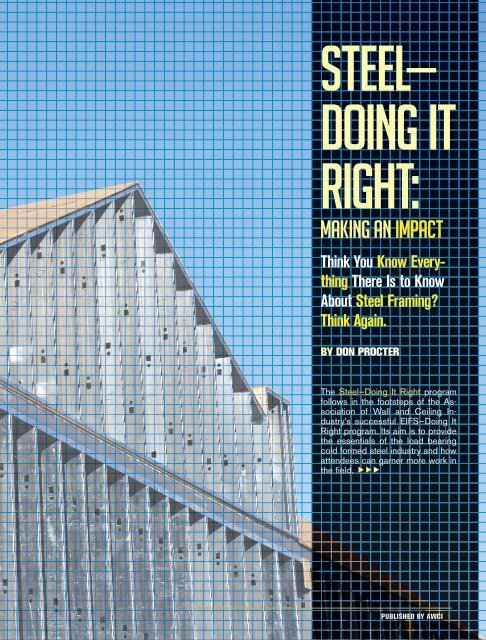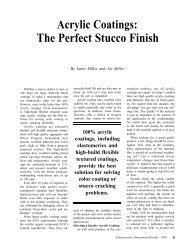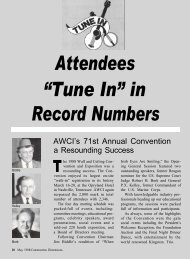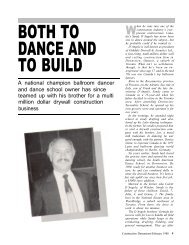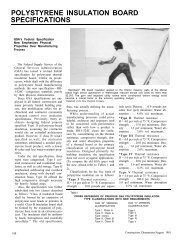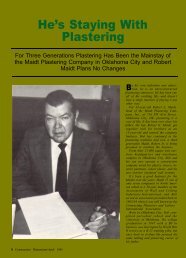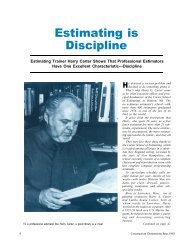SteelâDoing It Right - AWCI
SteelâDoing It Right - AWCI
SteelâDoing It Right - AWCI
Create successful ePaper yourself
Turn your PDF publications into a flip-book with our unique Google optimized e-Paper software.
Steel—<br />
Doing <strong>It</strong><br />
<strong>Right</strong>:<br />
Making an Impact<br />
Think You Know Everything<br />
There Is to Know<br />
About Steel Framing?<br />
Think Again.<br />
By Don Procter<br />
The Steel—Doing <strong>It</strong> <strong>Right</strong> program<br />
follows in the footsteps of the Association<br />
of Wall and Ceiling Industry’s<br />
successful EIFS—Doing <strong>It</strong><br />
<strong>Right</strong> program. <strong>It</strong>s aim is to provide<br />
the essentials of the load bearing<br />
cold formed steel industry and how<br />
attendees can garner more work in<br />
the field. <br />
PUBLISHED BY <strong>AWCI</strong>
Organized in partnership with the Steel Framing<br />
Alliance, the two-and-a-half-day seminar covers<br />
installation methods of cold-formed steel for<br />
most load-bearing and non-load bearing projects.<br />
“We see it as an ‘information buffet’ for our<br />
members to learn more about this market,” says<br />
Nancy Roylance, the <strong>AWCI</strong>’s director of education<br />
and certification programs.<br />
out. ”Remember, most of the attendees are relatively new<br />
to structural cold-formed steel framing. We want them to<br />
walk away with the most up-to-date information and best<br />
practices.”<br />
The seminar also offers information-sharing opportunities<br />
between attendees and instructors. “That in itself is a rich<br />
experience,” Roylance says.<br />
Maribeth Rizzuto, director of training and education of the<br />
SFA, adds that the content of the session will help people<br />
already working the field follow best design and installation<br />
practices. “Unfortunately we have a considerable number<br />
of practitioners both on the design side and the installation<br />
side who think they know what they really don’t know. Most<br />
are stunned to learn that the steel framing industry has very<br />
comprehensive standards, guidelines and installation details<br />
that need to be followed.”<br />
The program is a “broad sweep” of the cold-formed steel<br />
field and feedback from attendees at the six seminars put<br />
on since February 2006 has been “very favorable,” says<br />
Roylance.<br />
The seminar’s two instructors are industry experts with<br />
backgrounds in steel and engineering. PowerPoint presentations<br />
feature text, graphics and pictures. Real-life scenarios<br />
are portrayed, and each attendee is given<br />
a four-color<br />
w o r k b o o k<br />
that can be<br />
a handy resource<br />
later on<br />
in the field.<br />
The program<br />
also includes<br />
tabletop exhibits<br />
that illustrate<br />
examples of<br />
products and<br />
installations discussed<br />
in class.<br />
“Our goal is to<br />
bring the latest<br />
and greatest to<br />
the audience,”<br />
Rizzuto points<br />
Steel—Doing <strong>It</strong> <strong>Right</strong> is broken down into 13 modules, ranging<br />
from a look at steel framing materials and engineering<br />
considerations to basic and specialized construction. Load<br />
bearing, wind-bearing, curtainwall framing, interior systems,<br />
roof assemblies and panelization are covered in detail.<br />
The idea is to feed as much practical information as possible<br />
to attendees over the 2.5-day duration, says Roylance, noting<br />
that many members simply don’t have the time or the<br />
resources to educate themselves or their workers by other<br />
means. “They may not have the time to go to lengthy seminars<br />
or cull information from trade journals,” she says.<br />
Roylance makes a convincing case for why <strong>AWCI</strong> members<br />
should consider taking the course. The payoffs, she says,<br />
include increased production, better estimating techniques,<br />
improved project management skills and fine-tuned quality<br />
control methods.<br />
More Than You Know<br />
Mike Heering, regional vice president of F.L. Crane & Sons,<br />
Inc., Fulton, Miss., and nine fellow employees ranging from<br />
estimators to field staff, took the first seminar presented in<br />
Atlanta in February 2006. <strong>It</strong> exceeded his expectations: “I<br />
saw that it would fit a large group of participants, from field<br />
employees to managers and estimators. Every one of us<br />
came out of there, I guess you could almost say, ‘excited and<br />
surprised’ by the things we heard and learned.”<br />
While some experienced people in the industry might think<br />
they don’t need the program, Heering says a lot of people<br />
might be surprised at how much they learn. “With the way<br />
technology has been advancing, we see new products all the<br />
time and sometimes they have to be installed in a new way.<br />
Sometimes they just have to be installed differently to meet<br />
codes. Programs like this bring you up-to-date.”<br />
He says the program taught him various methods of calculating<br />
how to frame wall assemblies that could help reduce<br />
<strong>AWCI</strong>’S CONSTRUCTION DIMENSIONS | JULY 2007
costs—an important factor on bid day. On the last day of the program, practical estimating problems were dealt with, giving<br />
attendees an opportunity to put what they learned through the course into practice. For instance, estimators, field mechanics<br />
and field managers were required to calculate the hours it takes to perform various framing details. “<strong>It</strong> is a great way to start a<br />
person thinking while it is still fresh in their mind.”<br />
Heering adds that tabletop demonstrations helped make sense of assemblies discussed, such as a mock-up of details of Dietrich<br />
and The Steel Network Inc. products. In addition, a design firm provided software to illustrate how to design projects. “There’s<br />
not much more you can do unless you take everyone out on a job site for hands-on demonstrations,” Heering says. “The problem<br />
with that idea is that you’d have to stretch the program out to four or five days.”<br />
At F.L. Crane, Heering is responsible for keeping abreast of new technology that could benefit the company’s 13 branches. “One<br />
of the ways I can help is to bring good seminars like this one to the<br />
attention of my division managers. <strong>It</strong> might help in the continuing<br />
education of their estimators, field managers and their field employees,”<br />
he says.<br />
He expects that more employees of the company will go through<br />
future editions of the Steel—Doing <strong>It</strong> <strong>Right</strong> program. The key is<br />
lining up sessions that are accessible to employees from different<br />
branches.<br />
Some Tweaks Still Needed<br />
Another fan of the program is Fadi Abouhadid, estimator and project<br />
manager of Pillar Construction, Alexandria, Va. He signed up<br />
because he wanted to update his knowledge of the metal framing<br />
field, learn more about the bidding and building methods and network<br />
with industry counterparts.<br />
One of the 13 modules focused on metal roofing assemblies. That’s<br />
not normally a part of Pillar’s business, but he says the session was<br />
stimulating. “Some day we might pursue it,” Abouhadid says.<br />
Other sessions in the program proved helpful, too. The practical<br />
estimating exercise at the end of the program is an example. <strong>It</strong> gave students an opportunity to test themselves on what they<br />
learned. Still, Abouhadid says he’d like to see more emphasis on estimating early in the program.<br />
“Overall the program was well structured and explained,” Abouhidad says. “But there was so much information, it was little bit<br />
hard to digest it all in the two-and-a-half days.” The estimator/project manager suggests graphics—possibly film presentations<br />
illustrating construction methods—could facilitate the learning process.<br />
Jon Wies, estimator and project manager, of Wies Drywall & Construction Corporation in St. Louis, Mo., says the program met<br />
his expectations. “<strong>It</strong> is an excellent program for anyone who wants a comprehensive understanding of the nomenclature, construction<br />
methods and contractors’ issues concerning cold-formed steel framing,” he says.<br />
Wies points out that when he took the course, considerable emphasis was placed on the importance of bridging, bracing, blocking<br />
and backing. “They are peripheral items that might not come to mind when cold-formed steel framing is mentioned, but<br />
they are important nonetheless,” Wies says.<br />
PUBLISHED BY <strong>AWCI</strong>
How much a participant gets out of the program will depend<br />
on his or her level of skill and knowledge going into the<br />
course, Heering says. “I think that the PowerPoint session<br />
illustrated everything I needed to see.” Heering has experience<br />
as a field manager, project estimator and a manager of<br />
several divisions at F.L. Crane.<br />
<strong>It</strong>’s All in the Delivery<br />
Steel—Doing <strong>It</strong> <strong>Right</strong> was produced because of the potential<br />
growth in load bearing cold formed steel, Roylance says.<br />
“<strong>AWCI</strong> wanted to provide education to our members to bring<br />
the awareness and the knowledge of this market to them.”<br />
Roylance says the means of delivering the program material<br />
is as important as the material itself.<br />
Her role is to get the word out, not only to the membership<br />
in the <strong>AWCI</strong> and those in the SFA, but also to others in the<br />
building industry. “Up until now our energy has been put<br />
into building the program and honing it,” she says. “The Expert<br />
Advisory Group has done that; now, staff will focus on<br />
letting everyone know of this informative seminar.”<br />
In the first six seminars held since February 2006, the program<br />
has drawn 286 attendees. Roylance says the objective<br />
is to get 50 or so attendees at each of the four or more seminars<br />
planned over the next year. “With increased marketing<br />
and awareness of the program, we could see<br />
the need to add more<br />
seminars,” Roylance<br />
says.<br />
One of the first Steel—Doing <strong>It</strong> <strong>Right</strong> seminars was<br />
held in St. Louis, Mo.<br />
seminars for the employees of individual companies.<br />
Rizzuto says she’s pleased with the program to date. “<strong>It</strong> has<br />
given the SFA an opportunity to work in concert with <strong>AWCI</strong><br />
to bring comprehensive education and training to those<br />
who are looking to expand their work with cold-formed<br />
steel in structural application, in an interactive setting.” She’s<br />
also pleased that the program has been well-received by<br />
participants.<br />
Roylance expects<br />
that, similar to what<br />
happened with <strong>AWCI</strong>’s<br />
EIFS—Doing <strong>It</strong> <strong>Right</strong><br />
program, word-ofmouth<br />
marketing will<br />
carry a lot of weight as<br />
the program’s reputation<br />
grows. She says<br />
future seminars will be<br />
held in cities where the<br />
interest is strong and the<br />
location is easily accessible.<br />
Organizers are even<br />
willing to hold “by-request”<br />
However, based on a complete review of the program in December<br />
2006, which included feedback from participants,<br />
some adjustments to the curriculum have been made. The<br />
newest version launched in February 2007 has been field<br />
tested and positively accepted. Most of the changes relate to<br />
the length of some of the modules.<br />
“<strong>It</strong> is difficult when you are trying to cover so much territory<br />
in a condensed format to make it meaningful for the very<br />
diverse audience that we draw,” Rizzuto says.<br />
The need and the interest for the program came from the<br />
members of <strong>AWCI</strong> and SFA. The drivers were <strong>AWCI</strong> Executive<br />
Vice President Steve Etkin and SFA President Larry<br />
Williams, who worked with subject matter experts for the<br />
<strong>AWCI</strong>’S CONSTRUCTION DIMENSIONS | JULY 2007
content. Program sponsors include<br />
the American Zinc Association and the<br />
Steel Stud Manufacturers’ Association.<br />
Since the program has proven a success<br />
and organizers want to reach a<br />
larger audience, they are looking at a<br />
self-study alternative for people who<br />
don’t have time or need a more flexible<br />
learning means Roylance says.<br />
A late summer or early fall launch is<br />
planned for an on-demand interactive<br />
DVD format.<br />
About the Author<br />
Don Procter is a free-lance writer<br />
based in Ontario, Canada.<br />
For More Information<br />
Steel—Doing <strong>It</strong> <strong>Right</strong> costs about<br />
$450 for members of <strong>AWCI</strong> and SFA<br />
and $525 for nonmembers. For more<br />
information, contact <strong>AWCI</strong> at (703)<br />
538.1613 or visit www.awci.org/steel<br />
or SFA at (202) 785.2022 or visit www.<br />
steelframing.org.<br />
The Steel Framing Alliance offers a<br />
variety of other seminars on coldformed<br />
steel framing that are likely<br />
to fit specific needs. For more information<br />
on these seminars, contact<br />
the SFA at (202) 785.2022.<br />
Tabletop exhibits help attendees learn even more about steel framing.<br />
PUBLISHED BY <strong>AWCI</strong>


